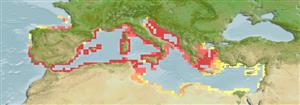>
Blenniiformes (Blennies) >
Blenniidae (Combtooth blennies) > Salariinae
Etymology: Parablennius: Greek, para = the side of + Greek, blennios = mucus (Ref. 45335).
Environment: milieu / climate zone / depth range / distribution range
Écologie
marin démersal; profondeur 0 - 42 m (Ref. 5981). Subtropical; 46°N - 30°N, 11°W - 36°E
Northeast Atlantic: off Portugal. Also known from the northern Mediterranean.
Taille / Poids / Âge
Maturity: Lm ? range ? - ? cm
Max length : 8.0 cm TL mâle / non sexé; (Ref. 5981)
Facultative air-breathing in the genus (Ref. 126274); Adults occur in the shallow littoral zone to the zone beyond the influence of water movements, over light rocks or pebbles without algal cover and on secondary hard bottoms of coralligenous origin. They feed on periphyton, harpacticoids and algae. Males inhabit narrow piddock holes; they court by nodding, jumping out of hole and back again and swimming in a vertical position. Rivals are threatened by yawning, lateral display and circling, and are attacked by ramming and biting. Reproduction takes place from May to July. Attracted females spawn in resident hole of a males which guards eggs from several families (Ref. 5981). Oviparous. Eggs are demersal and adhesive (Ref. 205), and are attached to the substrate via a filamentous, adhesive pad or pedestal (Ref. 94114). Larvae are planktonic, often found in shallow, coastal waters (Ref. 94114).
Life cycle and mating behavior
Maturities | Reproduction | Spawnings | Egg(s) | Fecundities | Larves
Oviparous, distinct pairing (Ref. 205).
Zander, C.D., 1986. Blenniidae. p. 1096-1112. In P.J.P. Whitehead, M.-L. Bauchot, J.-C. Hureau, J. Nielsen and E. Tortonese (eds.) Fishes of the North-eastern Atlantic and the Mediterranean, volume 3. UNESCO, Paris. (Ref. 5981)
Statut dans la liste rouge de l'IUCN (Ref. 130435)
Menace pour l'homme
Harmless
Utilisations par l'homme
Outils
Articles particuliers
Télécharger en XML
Sources Internet
Estimates based on models
Preferred temperature (Ref.
123201): 16.5 - 19.5, mean 18.1 °C (based on 54 cells).
Phylogenetic diversity index (Ref.
82804): PD
50 = 0.5000 [Uniqueness, from 0.5 = low to 2.0 = high].
Bayesian length-weight: a=0.00741 (0.00335 - 0.01640), b=3.02 (2.83 - 3.21), in cm total length, based on LWR estimates for this (Sub)family-body shape (Ref.
93245).
Niveau trophique (Ref.
69278): 3.0 ±0.0 se; based on diet studies.
Résilience (Ref.
120179): Haut, temps minimum de doublement de population inférieur à 15 mois (Preliminary K or Fecundity.).
Fishing Vulnerability (Ref.
59153): Low vulnerability (10 of 100).
Nutrients (Ref.
124155): Calcium = 295 [156, 644] mg/100g; Iron = 1.6 [1.0, 3.0] mg/100g; Protein = 18.1 [17.1, 19.1] %; Omega3 = 0.263 [0.141, 0.481] g/100g; Selenium = 20 [9, 43] μg/100g; VitaminA = 22.1 [6.4, 74.0] μg/100g; Zinc = 1.51 [0.99, 2.22] mg/100g (wet weight);
